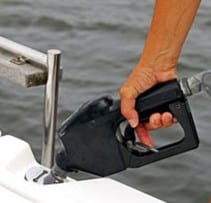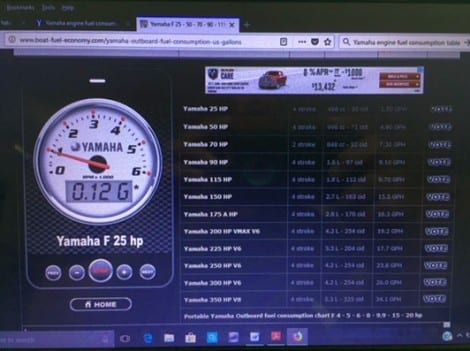 By Bob Currie, Vessel Examiner
By Bob Currie, Vessel Examiner
United States Coast Guard Auxiliary Flotilla 081-06-08
USCG Auxiliary Flotilla 081-06-08 is based at Coast Guard Station Galveston. The Auxiliary’s vessel examiners perform safety checks on all types of recreational boats. The list of equipment required by federal law is very minimal; however, the Coast Guard has several recommendations for consideration by the prudent and safe recreational boater. Many of the recommendations for recreational boaters are actually required of commercial vessels.
Fueling
Gasoline and gasoline fumes are dangerous and can easily explode. Gasoline vapors are denser than air, meaning these vapors will sink and collect at the lowest point. Effective air circulation may help disperse gasoline vapors. An open flame is not necessary to ignite gasoline vapors; one spark can cause gasoline vapors to ignite. Boaters need to take special precautions to prevent gasoline related fires and explosions before fueling their vessels, while fueling their vessels, and after fueling.
Before Fueling

- Remove all portable fuel tanks from the vessel and place them on the dock.
- Close all ports, hatches, and other openings do gas vapors don’t float into those spaces.
- Extinguish all smoking materials. A No Smoking policy on board is even better.
- Turn off all engines, electrical equipment, radios, stoves, and other appliances.
- Ask passengers to leave the boat for their safety.
- Fuel away from the water if you can; this eliminates many hazards of fueling.
- Check to see that fuel lines, connections, and fuel vents are in good condition.
- Make sure your fire extinguisher is within reach.
- Close up the boat so that gas vapors don’t float into hatches and ports.
During Fueling
- Fill your own tank. Guests may not know what precautions to take.
- Keep the fill nozzle in direct contact with the tank or fill nozzle to prevent sparking due to static electricity.
- Stop pumping when close to full. With portable tanks, this reduces the chance of sloshing gasoline out onto the dock. With permanent tanks, this prevents gas from remaining in the fill hose, which is not designed to store gasoline.
- It is best to leave about 5% of the tank empty to allow for expansion.
After Fueling
- Clean up and report any fuel spills. Collect fuel or oil that has spilled into the water near your boat with oil-absorbing pads and sausages.
- Any discharge of oil or fuel that creates a sheen, sludge or emulsion on the surface or beneath the water is considered harmful and requires a call to the National Response Center.
- Open all ports, hatches, and doors to help ventilate the vessel.
- Check the bilge for fuel vapors before starting the engine.
- Sniff around the areas both inside and outside the boat to make sure there is no gasoline odor anywhere.
- Run the boat’s blower system for at least four minutes before starting the engine.
- Start the engine when satisfied that such action is safe, and only then ask passengers to come aboard.
Fuel Management
Boaters should take special precautions to avoid running out of fuel. One easy to remember formula is to allocate one third of the vessel’s total fuel supply for traveling to your destination, one third for returning to port, and one third to hold in reserve. This formula requires you to have good knowledge of your fuel consumption under different conditions. Your engine manufacturer may be able to help you by providing a fuel consumption table as a starting point. You should modify such table as necessary to fit your boat and load. This link will help you get started if your engine is an outboard model:
Before you create your own fuel consumption table, it is wise to use your engine manufacturer’s reported maximum gallons per hour (GPH) usage as a starting point. The Yamaha interactive guide shown is based on moderate loads for a hypothetical boat, but it gives you a pretty good idea of the fuel usage based upon RPMs.
If you should find yourself becoming short on fuel on your way back in, the best thing you can do is reduce speed.  Using the Yamaha 115 HP engine as an example, at 6000 RPM the engine consumes 9.7 GPH; at half speed (3000 RPM) it consumes 2.6 GPH; at one third speed (2000 RPM) it consumes 1.0 GPH. If you consider cruising speed to be three fourths throttle, the 115 HP Yamaha consumes 5.8 GPH at 4500 RPM. You almost double your fuel consumption from 4500 RPM to 6000 RPM. Working backwards from cruising speed, you can see that your fuel consumption drops dramatically. It might take you much longer to get home by reducing speed, but you will eventually get there! Hopefully you have filed a float plan and have that recommended marine radio aboard and you will not have to resort to critical measures to make it back to port.
Using the Yamaha 115 HP engine as an example, at 6000 RPM the engine consumes 9.7 GPH; at half speed (3000 RPM) it consumes 2.6 GPH; at one third speed (2000 RPM) it consumes 1.0 GPH. If you consider cruising speed to be three fourths throttle, the 115 HP Yamaha consumes 5.8 GPH at 4500 RPM. You almost double your fuel consumption from 4500 RPM to 6000 RPM. Working backwards from cruising speed, you can see that your fuel consumption drops dramatically. It might take you much longer to get home by reducing speed, but you will eventually get there! Hopefully you have filed a float plan and have that recommended marine radio aboard and you will not have to resort to critical measures to make it back to port.
For more information on boating safety, please visit the Official Website of the U.S. Coast Guard’s Boating Safety Division at www.uscgboating.org. Questions about the U.S. Coast Guard Auxiliary or our free Vessel Safety Check program may be directed to me at [email protected]. I am available to perform free Vessel Safety Checks, and I will come to your location to perform them. SAFE BOATING!
[12-11-2017]

 Posted in
Posted in 























